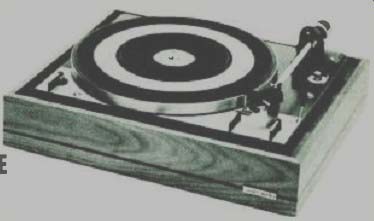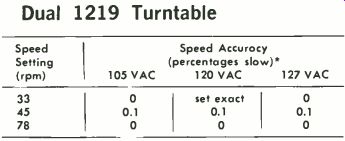
Dual's New Top-Of-Line Automatic Turntable
THE EQUIPMENT: Dual 1219, an automatic three-speed turntable with integral arm. Dimensions: chassis plate, 14 3/4 by 12 inches; allow 4 inches above and 3 inches below.
Price, less cover and base: $175.
Manufactured by Dual of West Germany; distributed in the U.S. by United Audio Products, Inc., 120 S. Columbia Ave., Mt. Vernon, N.Y. 10553.
COMMENT: The new top-of-the-line automatic from Dual shows evidence of refinement in significant performance areas. For instance, speed accuracy is greater than in the 1019, wow and flutter are a bit lower, tracking force and antiskating adjustments are more precise. The 1219 is, in fact, outstanding in all these characteristics. We cannot compare its rumble level with that of the 1019 inasmuch as a different test method was used for the older model, but its CBS-ARLL figure of -54 dB represents a good average figure for automatics. In any event, the extremely low arm resonance in the 1219 (an 8-dB rise at 7.3 Hz, when tested with the Shure V/15 Type II) would be a factor in keeping down any intrusion of motor noise.
A three-speed (33, 45, and 78 rpm) model, the 1219, may be used as a single-play turntable with automatic or manual start and cueing as you choose, or as an automatic changer for sequential playing of up to six discs. The unit also can be used to play the same record repeatedly. During automatic operation, you can reject a record at any time; during any mode of operation you can manipulate the built-in cueing device to interrupt and resume play at any portion of a record.
Speed is selected by a three-position lever which is fitted concentrically into a pitch-control knob that varies the speed over a six-percent (plus or minus 3 percent) range-useful for compensating for minor irregularities in line voltage or for deliberately varying musical pitch to suit individual requirements. With this adjustment set for exact speed at the 33-rpm setting, CBS Labs measured speed accuracy for the other speeds and found it to be extremely close at all line voltage inputs (see accompanying table). Absolute accuracy can be achieved readily by the user with the help of the three-speed strobe disc supplied with the unit. In addition to the speed controls there's a start /stop lever and a record-diameter adjustment with settings for 7, 10, and 12 inches. The platter itself weighed in at 7 pounds, 13 ounces (slightly heavier than the old 1019). Its average wow and flutter measured a very low 0.05 percent.
The tone arm is a metal tubular type fitted at its pivot end with a removable and adjustable counterweight, a stylus tracking-force adjustment, an anti-skating system which includes a dial calibrated separately for use with conical and elliptical styli, and a novel adjustment for optimizing vertical tracking angle for either single-play or stack-and-play. The stylus-force calibration is virtually lab-accurate, with the following figures measured (first number is the setting on the built-in gauge; second number is the actual stylus force measured): 1.0, 1.0; 1.5, 1.5; 2.0, 2.1: 3.0, 3.1. The antiskating, or bias, compensation introduces (correctly) slightly higher compensation for an elliptical stylus than for a conical. The vertical-angle adjustment raises the arm at its pivot end to compensate for the change in attitude undergone by the arm when playing more than one disc on the platter. The change mechanism performs smoothly and quietly; the change cycle takes eleven seconds and requires a very low 0.07-gram of stylus force to activate the automatic trip. Arm friction, laterally and vertically, is negligible.
The pickup-end of the arm is fitted with a lightweight shell that has a removable platform onto which you install the cartridge. A plastic gauge, supplied, helps zero in for accurate stylus overhang. The cueing device permits the arm to descend very gently onto a record, and the arm rest and latch hold the arm securely when not in use. As we found in previous Dual models, everything works smoothly and flawlessly, and the chassis plate's spring-loaded mounting system makes it easy to install on its base while also lending the unit a high immunity to external shock.
The 1219 comes with a single-play spindle, an automatic spindle, a 45-rpm doughnut adapter, the three-speed strobe disc, the stylus overhang gauge, and prewired signal and power cables. An optional walnut base costs $14.95 (if you don't fashion your own base from the template supplied), and a dust cover lists for $12.95.

----------- Dual 1219 Turntable Speed Setting (rpm)
33 45 105 VAC Speed Accuracy (percentages slow) 120 VAC 127 VAC
*Measurements made with vernier speed control set for exact speed at 33-rpm setting, using 120 volts AC, 60-Hz power line. Control may be adjusted by user for exact speed (i.e., zero error) at other settings and for varying power line voltages.
-------------
(High Fidelity)
Also see:
Stanton Model 881S phono cartridge (Equip. Report, Nov. 1977)
Harman-Kardon CAD-4 cassette recorder (Equip. Report, Jan. 1970)